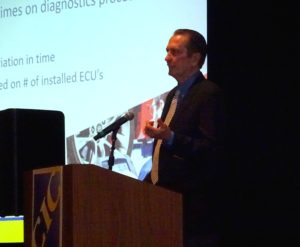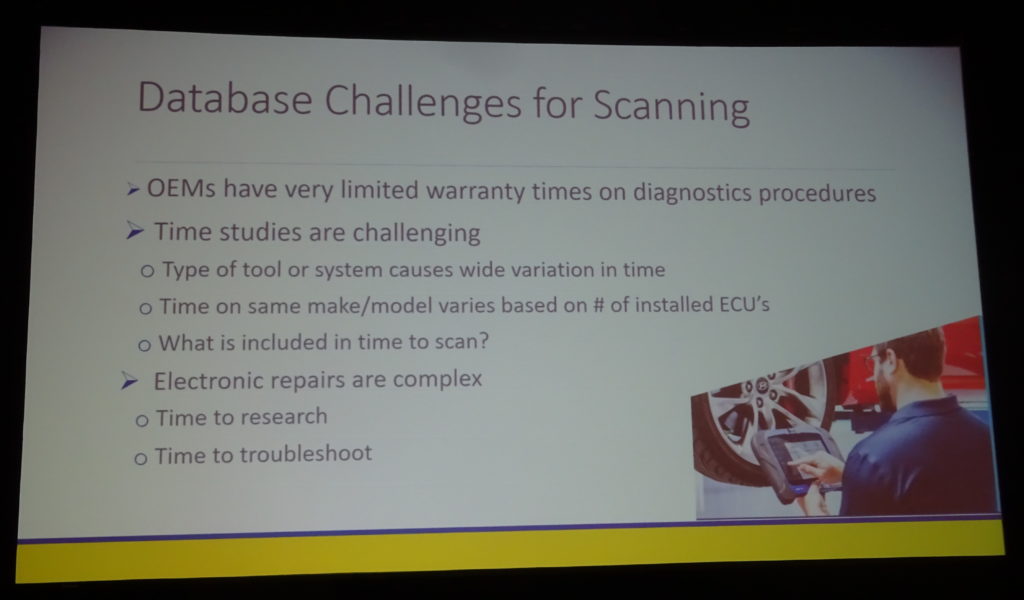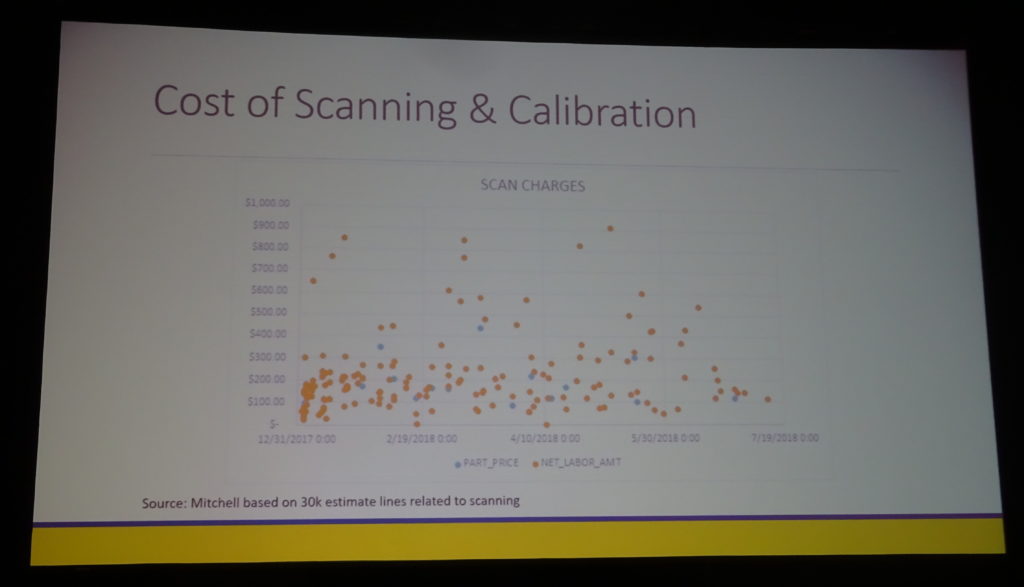
Mitchell explains why no scanning book time exists
By onBusiness Practices | Education | Market Trends | Repair Operations | Technology
The sheer variety of diagnostic methods and vehicle options hindered Mitchell’s ability to set a definitive scanning book time, repair sales and service Vice President Jack Rozint told the Collision Industry Conference on Thursday.
Rozint’s comments during his CIC Emerging Technologies Committee presentation help shed light on a question he said his information provider receives.
Rozint said five different ways exist to scan a vehicle — something his CIC committee has highlighted in its extensive work summarizing such issues. They include running the diagnostic check in-house with an OEM scan tool or an aftermarket scan tool; connecting remotely to a scan provider (e.g. AirPro or asTech); subletting to a mobile technician; and subletting to a dealership, he said.
All five have different labor times and couldn’t be normalized, Rozint said.
P-pages
Due to the wide range of collision damage and vehicle conditions, labor times for the following operations are not included in the Guide …
Pre/Post Repair Scans
OEM recommendations may include pre/post-repair scan(s) on vehicles involved in a collision to assist in discovery of any specific Diagnostic Trouble Codes (DTC’s). Refer to OEM specific position statement(s) and/or repair procedures for additional information.
CCC in October 2018 updated its P-pages to make a similar point as Rozint:
“Due to the variety of scan tools used, both OEM and aftermarket, as well as the variation from vehicle to vehicle and repair to repair, MOTOR is unable to develop a time that accounts for these different scenarios,” CCC wrote. “Therefore, MOTOR recommends an on-the-spot evaluation to determine an appropriate estimated time to perform diagnostic scans for each repair.”
Database Enhancement Gateway Administrator Danny Gredinberg said last fall he had discussed the issue with CCC. He said he felt it was better to leave this value open, for there are “too many scenarios involved,” he said.
The scan tool might not even communicate with the vehicle when attached due to the nature of the damage, or wires might be damaged by the collision, he said. Conversely, a lighter hit might not require as much scanning time. Different scan tools might behave differently as well, according to Gredinberg, giving the example of an OEM tool which have prerequisites before accessing a module, while an aftermarket tool might jump right to it.
He contrasted this with a wheel alignment, which he said had similar procedures regardless of alignment machine manufacturer. “There’s only one way” to do it, he said, and “they’re all performing the same measurement.”
Audatex also lists pre- and post-repair scanning among its “Labor Exclusions” (except on Teslas through November 2017), prefacing the list by writing, “Because each vehicle’s collision damage is unique, labor to perform some of the following operations may vary.”
The Society of Collision Repair Specialists on Monday posted a video demonstrating some of the steps which a remote scan could entail.
SCRS Executive Director Aaron Schulenburg told the CIC, which received a special screening of the film, that members had told the organization they were having issues explaining scanning, particularly in-house work.
“There’s a perception that maybe all it is is plugging something in, magic happens and it gets unplugged … that’s not quite the case,” Schulenburg told the CIC.
More issues
Even using the same scan tool might produce different labor times for two vehicles of the same year, make and model if the build data varies, according to Rozint. Scanning a base model might only mean the software checking 20 controllers, but a fully loaded variant of the vehicle might have 45-50 controllers to scan, which takes longer, he said.
Rozint said what is considered part of the scanning operation is a source of debate. He gave the example of whether time to research diagnostic trouble codes would be included. (Something that would be more involved than just plugging a tool in and receiving its results.)
“All that’s being worked on,” including by Mitchell, Rozint said.
But you couldn’t put a book time on research and troubleshooting, he said.
No consistent, concrete price for scanning exists either, Mitchell records indicate. Rozint said his IP searched its database of historical estimates looking for common words related to scanning or major diagnostic provider brands.
“It’s all over the map,” he described the results presented to CIC.
Some repairers billed for scanning with a flat-rate charge (seen below in blue), while others tied the amount to labor hours (seen below in orange). Some bills exceeded $1,000 in instances where the vehicle had to be sent to a dealer for “scanning and recalibration,” Rozint said. (Which sounds like technically two sublet operations, which might explain the price.)
More information:
Collision Industry Conference, July 19, 2017
CIC Emerging Technologies Committee
Images:
Mitchell repair sales and service Vice President Jack Rozint and CIC Emerging Technologies Committee Chairman speaks to the Collision Industry Conference on Jan. 17, 2019. (John Huetter/Repairer Driven News)
The sheer variety of diagnostic methods and vehicle options hindered Mitchell’s ability to set a definitive scanning book time, repair sales and service Vice President Jack Rozint told the Collision Industry Conference on Jan. 17, 2019. (Slide by Mitchell/CIC Emerging Technologies Committee; photo by John Huetter/Repairer Driven News)
The Database Enhancement Gateway in October 2018 posted this cheat sheet dictating what is and isn’t included on operations related to scanning and calibration. (Provided by the DEG)
Mitchell repair sales and service Vice President Jack Rozint showed the Collision Industry Conference Mitchell data on Jan. 17, 2019, indicating scan prices were “all over the map.” (Slide by Mitchell/CIC Emerging Technologies Committee; photo by John Huetter/Repairer Driven News)



